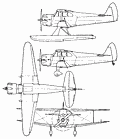| Cholet, e-mail, 03.11.2011 10:45 Extrait du site de la Shumaker collection
09 /30 /2011. The story of the Queen Wasp is one which typifies the necessarily varying policies and requirements as the situation changed from one of imminent and expected war, through the phony period following declaration of war and on to the real thing. This attractive little biplane was originally ordered in May 1936 and designed and built as the AS.30 to meet Air Ministry specification Q.32 /35 for a faster and more effective radio-controlled, pilotless aircraft, in landplane and seaplane versions, to supplant and supplement the Queen Bee variant of the de Havilland Tiger Moth already being used for live gunnery practice.
The Queen Wasp, much too good-looking to be shot out of the sky, was a single-bay biplane with folding wings, mainly of wood construction, and powered by a 350 hp Armstrong Siddeley Cheetah IX seven-cylinder radial. The center-section was built integrally with the fuselage, and the outer wings were of two-spar ply-covered construction with fabric-covered slotted flaps and ailerons. The fuselage was in three sections, with the middle portion carrying the centre-section.
Access to the single-seat cockpit was by way of a door in the starboard side between the spar-mounted bulkheads. A transparent sliding panel in the roof between the bulkheads and spars provided access to the slinging gear and wing-joint pins and served also as an emergency exit. Slotted flaps were fitted to the trailing edge of the top wing, extending over the whole outer spans. Slotted ailerons were on the lower wing only and were interconnected with the flaps so that these and the ailerons were lowered together.
Two prototypes, K8887 with a land undercarriage and K8888 with floats, were built and flown in 1937. The land plane prototype made its initial flight, in the hands of G.B.S. Errington, from Portsmouth Airport on June 11, 1937, and was seen publicly for the first time at the RAF Display, Hendon, at the end of that month among the new and experimental aircraft. The seaplane prototype was flying soon afterwards and was successfully catapulted from the carrier HMS Pegasus (ex-HMS Ark Royal) in November.
Those who flew the later Queen Wasps say that the slow-speed characteristics were not all that could be desired, however, both the land plane and seaplane prototypes survived the test-flying period without serious mishap. The first flight of the seaplane was made by Flt. Lt. C.H.A. Colman, who had never previously handled either a floatplane or flying-boat. Incidentally, in tank tests at Farnborough the original Short-built floats were found to be unsatisfactory because of pitching instability. After the RAE had developed a better design, Shorts produced their own alternative which, after some modifications, was equally satisfactory.
In automatic flight the Queen Wasp was controlled by an air-driven gyroscope unit which maintained the status quo by corrections made through pneumatic servos to the rudder and elevator (the ailerons were locked in the neutral position). Changes of heading or attitude, as signaled by radio from the ground with coded dot-dash signals, were made by suitably processing the gyro with a system of air-driven pistons. There were three radio-controlled throttle positions-fully open, half open for cruise power, and closed. The throttle movement was interconnected with a complicated device to counteract the effects of acceleration and deceleration on the gyro. A servo motor lowered the flaps when 'landing glide' was demanded by radio signals, but only when the speed was right. Regardless of any lack of radio instructions an altimeter contact system automatically initiated a pull-out to the fast level full-throttle condition below a pre-set altitude.
A weighted trailing aerial, automatically winched out by air-speed-indicator signal after take-off or catapulting, served the dual purpose of radio aerial and automatic-landing activator. When the weight struck the ground, contacts on the winch caused an electrically operated spring-loaded valve to apply up elevator and short-circuited all air supplies to the gyroscope and other valves. When the aerial touched, the Queen Wasp was thus committed finally to its own landing, for better or for worse.
This relatively straightforward auto landing system, however, provided problems of its own. In very bumpy weather the trailing aerial could snatch sufficiently vigorously to give the unthinking system the idea that a landing should be initiated. So a relay was introduced into the system to forestall automatic action before a 'landing glide' signal had been received.
When serious failures occurred the systems were arranged for the aircraft to enter a flaps-down engine-off glide in a gentle left turn, so that, at the worst, an automatic landing might be made not too far from base. Engine failure left the Queen Wasp in a flaps-down glide in a slow turn to port. Battery failure left it in a f ... reply |



 Cholet
Cholet




Would really like to see the entire article on this aircraft, if you have access to this?
Am trying to gather together information on this airframe and it’s proving quite difficult. Your description is the closest I’ve come to gaining an insight iron the construction of this plane.
I look forward to hearing from you soon
Kind regards
Nick.
reply